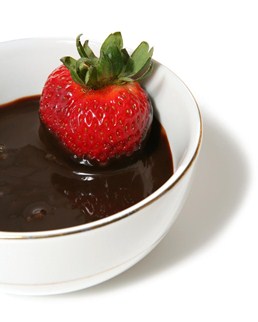50-Minute Classroom: Chocolate Dipping
31 January 2012
 Not only will your students enjoy this assignment, but this will probably be one of the few times in your class that they can create unique dishes.
Not only will your students enjoy this assignment, but this will probably be one of the few times in your class that they can create unique dishes.
By Adam Weiner, CFSE
In honor of February, why not have a 50-minute class on chocolate dipping? Before you read further, here is a disclaimer: I am neither a chocolatier nor a pastry chef. If you are either, please stop reading. For the rest of us mere mortals, let me show a quick, easy and fun way to teach some basic chocolate-dipping skills:
1. Preparation: Mise en place is critical here. Like cooking, chocolate work requires that everything be ready to go before you start. Remind students that mise en place applies to equipment as well as ingredients. (My students somehow always seem to forget this.)
Cut apples (held in a little lemon water to keep from turning brown), whole strawberries, dried apricots, pretzels, cookies, marshmallows and graham crackers are just some of the many items perfect for dipping. They should all be out of the packages and ready to go before melting the chocolate. In my view, however, the most fun thing to dip is frozen bananas. Peel them the day before, put a popsicle stick lengthwise into each banana, place the bananas on a parchment-lined baking sheet and freeze overnight (or for at least four hours.)
Although chocolate alone is always wonderful, flat pans or trays of chopped nuts, colored sprinkles, pulverized candy bars, chopped-up gummy bears, broken-up cookies, etc., are a fun and colorful addition. Further, this will probably be one of the few times in your class that a student can create a unique dish.
2. Melt the Chocolate. Show students how to use a bowl to make a double boiler and explain why you keep the heat low to minimize the chance of steam coming into the bowl and seizing the chocolate. (To speed up the process, get the pots of water simmering in the breaks between classes.) For each team of four, I recommend about 32 ounces of bulk chocolate shaved or chocolate chips along with a couple of tablespoons of butter or milk to even out the chocolate as it melts. Remind students to only stir the chocolate occasionally and to be gentle to minimize the chance of seizing by upsetting the bowl on the pot.
3. Removed the Chocolate from the Heat. To facilitate rolling the items in the chocolate, I recommend that the chocolate be transferred to a preheated 2-inch half pan or some other flat container. Remind students that they will have to work fast because the chocolate will start hardening up. Of course, you can turn off the heat and just leave the entire double-boiler set together. This will keep the chocolate at the right consistency longer. The food is harder to dip or roll in a bowl, however, and the chance of injury is higher with multiple students trying to dip their food over a hot double boiler.
4. Sit Back and Enjoy the Look on Your Students’ Faces. They will be in Nirvana as they watch their masterpieces come to fruition, and then sparkle with pride and passion as they enjoy them and share them with others.
If that sounds easy, it is. One more suggestion, however: Leave extra time for cleaning—particularly your students’ faces.
Happy Valentine’s Day.
Chef Adam Weiner, CFSE, teaches a 20-week Introduction to Cooking program for JobTrain on the San Francisco Peninsula.
Photo: © Stephen Coburn | Dreamstime.com, http://www.dreamstime.com/strawberries-and-chocolate-imagefree2769557
